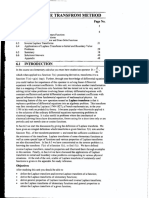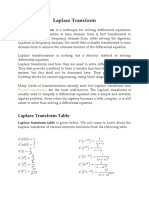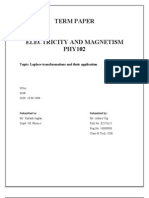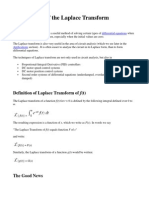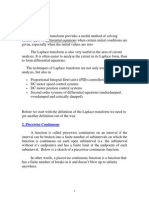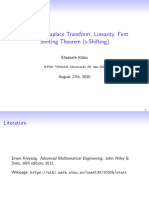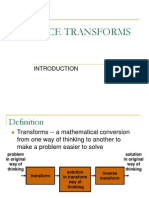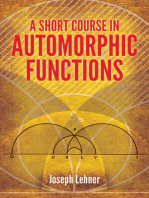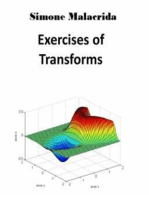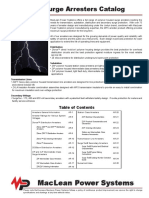AdvMath (Unit 2)
Uploaded by
Ivan Paul SyAdvMath (Unit 2)
Uploaded by
Ivan Paul SyAdvanced Engineering Mathematics
LAPLACE AND INVERSE LAPLACE TRANSFORM The Laplace transforms and its inverse has many important applications in mathematics, physics, economics, engineering, and probability theory. Pierre Simon Marquis de Laplace originally developed the integral transform for his work on the probability theory. However, the powerful, practical Laplace transform techniques were developed only a century later by Oliver Heaviside. The Laplace transform, because of its properties, makes solving ordinary differential equations much easier by making operations in calculus algebraic. Moreover, compared to other transform techniques (such as Fourier transform), the Laplace transform virtually exists to almost all kinds of functions, subject to certain restrictions. It is then ideal to use Laplace transform to analyze systems modeled by differential equations and are causal in nature. Let f t be a causal function, so f t = 0 for t < 0. The Laplace transform F s of f t is the complex function defined for s by F s = e f t dt (2.1) 2.1 Definition, Existence and Uniqueness of the Laplace Transform
provided that the integral exists.
The Laplace transform basically maps the function f t , which is in t-domain (in applications, time-domain) into s-domain (which we will call later as the complex frequency domain). We shall use the following notation f =F s (2.2a)
read as the Laplace transform of the function f t is the function F s , and which denotes the inverse Laplace transform of the function F s is the function f t . Also take note that the original functions f t depend on t and their transforms F s depend on s. We shall use lowercase letter for the original functions and the same letter in upper case to denote their transforms. In Eq. 2.1 we need to evaluate the integral from zero to infinity; such integrals are called improper integrals. Improper integrals are evaluated according to the rule e f t dt = lim
F =f t
(2.2b)
f t dt
(2.3)
Laplace and Inverse Laplace Transform
Page 1
Advanced Engineering Mathematics
Note that the function f t must be causal, that is its value is f t when t Example 2.1 Using the Laplace integral, find the Laplace transform of the following: (a) f t = (b) f t = e , is a constant (c) f t = t (d) f t = s t, is a constant (e) f t = si t, is a constant Answers: (a) F s = (d) F s = (b) F s = 0 and 0 when t < 0.
(c) F s =
(e) F s = A function f t has a Laplace transform if it does not grow too fast, say, if for all t and it satisfies the growth restriction f t e 0 and some constants (2.4)
The function f t also need not to be continuous in the whole interval, rather it should be piecewise continuous. A function is piecewise continuous on a finite interval t where f is defined, if this interval can be divided into finitely many subintervals in each of which f is continuous and has finite limit as t approaches either endpoint of such a subinterval from the interior.. Figure 2.1 illustrates a piecewise continuous function as an example.
We can now state the existence of the Laplace transform in the following manner: if f t is defined and piecewise continuous on every finite interval on the semi-axis t 0 and satisfies the growth restriction (Eq. 2.4) for all t 0 and some constants and then the Laplace transform f exists for all s .
Figure 2.1. A Piecewise Continuous Function
Laplace and Inverse Laplace Transform
Page 2
Advanced Engineering Mathematics
It can also be seen that when the Laplace transform of a given function exists, it is uniquely determined. In the same manner, the inverse of a given transform is essentially unique. 2.2 General Properties of Laplace Transform: Linearity, s-shifting. Table of Laplace Transform.
Because of some basic properties and the uniqueness of Laplace transform, we can deviate from using the Laplace integral to all functions. All we need is to derive the Laplace transform of basic functions then apply the properties. At the end of this section, a table of Laplace transform is presented. Linearity Just as differentiation and integration are linear, Laplace transform is also a linear operation, that is for any functions f t and g t whose transforms exist and any constants and , the transform of f t + g t exists and f t + g t = f t + g t = F s + G s (2.5)
Example 2.2 Using the linearity theorem, and the previously obtained Laplace transform pairs, find the Laplace transforms of (a) sh t (b) si h t (c) s t (d) si t First shifting theorem: Shifting in the s-domain The Laplace transform has the very useful property that if we know the transform of f t , we can immediately get that of e f t , as follows: If f t has the transform F s (where s for some ), then e f t has the transform F s (where s for some ). Thus, e f t = F s e f t = F s (2.6a) (2.6b)
Example 2.3 Apply the shifting theorem and the previously obtained Laplace transform pairs to obtain the Laplace transform of the following: (a) e s t (b) e si t
Laplace and Inverse Laplace Transform
Page 3
Advanced Engineering Mathematics
The table below shows the Laplace transform pairs we have obtained in the previous examples.
Figure 2.2 Table of Laplace Transform Pairs
Example 2.4 Find the Laplace transform of the following functions using the table (variables other than t are considered constants) (a) t t (b) s t (c) e sh t (d) e (e) s t +
We havent proved formulas 3, 4 and 5 yet, however, they can be obtained from formula 2 by induction. Formulas 1 thru 3 are special cases of formula 4 (note that 0 = , which applies for formula 1).
Laplace and Inverse Laplace Transform
Page 4
Advanced Engineering Mathematics
Answers (a) (b) (c)
(d) (e) Example 2.5 Find the inverse Laplace transform of the following functions using the table (variables other than s are constants) (a) (b) (c) (d) (e) Answers: (a) 4 s t 3 si (b) t + t (c) 3e si 5t (d) e (e) t
Laplace and Inverse Laplace Transform
Page 5
Advanced Engineering Mathematics
Drill Problem 2.1 Find the Laplace transform of the following functions. Variables other than t are constants. 1. t 3 2. si 4t 3. e si h 5t 4. si 3t 5. 8 si 0. t 6. si t s t 7. t + 8. 3.8te . 9. 3t e . 10. 5e si t
Find the inverse Laplace transform of the following functions. Variables other than s are constants. 11.
12. 13. 14. 15. 16. 17. 18. 19. 20.
Laplace and Inverse Laplace Transform
Page 6
Advanced Engineering Mathematics
2.3 Transforms of Derivatives and Integrals. Solutions of Ordinary Differential Equations The power of Laplace transform underlies in the fact that it can transform calculus operations into algebraic operations. This is due to its differentiation and integration properties. Thus, it is a very useful tool in solving initial value problems in ordinary differential equations. Differentiation Property The Laplace transform of the first derivative of f t is f t = sF s f 0
(2.7a)
provided f t is continuous for all t 0 and satisfies the growth restriction and f t is piecewise continuous on every finite interval on the semi-axis t 0. The Laplace transform of the second derivative of f t is provided f t and f t are continuous for all t 0 and satisfy the growth restriction and f t is piecewise continuous on every finite interval on the semi-axis t 0. By induction, we can then have the Laplace transform of the -th derivative of f t as f t = s F s s f 0 s f 0 f 0 (2.7c) provided f up to f are continuous for all t 0 and satisfy the growth restriction and f piecewise continuous on every finite interval on the semi-axis t 0. Example 2.6 Find the Laplace transform of the following using the differentiation property: (a) te (b) t si t (c) si t Answers: (a) (b) f t = s F s sf 0 f 0 (2.7b)
be
(c)
Laplace and Inverse Laplace Transform
Page 7
Advanced Engineering Mathematics
Integration Property For a function f t that is piecewise continuous for t restriction, then for s 0, s , and t 0, f d = s F s 0 and satisfies the growth (2.8)
where F s is the Laplace transform of f t .
Example 2.7 Find the inverse Laplace transform of the following using the integration property. (a) (b) Answers: (a) (b) s t
Take note that multiplication by s in s-domain is differentiation in t-domain and division by s in s-domain is integration in t-domain. This is the very useful property of the Laplace transform that makes it an ideal tool in solving differential equations and initial value problems. In illustrating how Laplace transform can solve initial value problem, consider the examples below: Example 2.8 Find the general solution of the differential equation (a) y + y + y = 0 for y 0 = and y 0 = 3 (b) y y = t for y 0 = y 0 =
Answer: (a) y = e s t si t (b) y = e + si h t t
The Laplace transform method of solving differential equations has the following advantages: Solving a nonhomogenous ODE does not require first solving the homogenous ODE. Initial values are automatically taken care of. Complicated R t (right sides of linear ODEs) can be handled very efficiently.
Page 8
Laplace and Inverse Laplace Transform
Advanced Engineering Mathematics
Drill Problems 2.2 A. Use the differentiation property to find the Laplace transform of the following: 1. t s 5t 2. s t 3. si h t 4. sh t 5. si t B. Use the integration property to find the inverse Laplace transform of the following: 6. 7. 8. 9. 10. C. Solve the following differential equations using Laplace transforms: 11. y + 4y = 0, y 0 = .8 12. y + y = 7 si t, y 0 = 13. y y 6y = 0, y 0 = 6, y 0 = 3 14. y 4y + 4y = 0, y 0 = . , y 0 = 3.9 15. y + y y = 0, y 0 = , y 0 = 2.4. Unit Step Function. t-shifting. The unit step function or the Heaviside function u t is 1 for t or in a formula, u t = 0, , is 0 for t < , has a jump size of 1 at t = , and t< t (2.9)
The special case of step function u t for which positive constant is shown in the figures below.
= 0 and the general case u t
for an arbitrary
Laplace and Inverse Laplace Transform
Page 9
Advanced Engineering Mathematics
The transform of u t
Figure 2.3. The unit step function u(t) and its shifted version u(t-a)
can be found using the Laplace transform integral and is given as u t = e s (2.10)
The unit step function is typical engineering functions made to measure for engineering applications which often involve functions that are either off or on. Multiplying functions f t with u t can produce all sorts of effects, as in examples illustrated below.
The second-shifting theorem: t-shifting If f t has the transform F s , then the shifted function f t u t has the transform e F s , that is If the conversion of f t to f t f t u t = e F s (2.11)
Figure 2.4. Illustration of the effect of multiplication of the unit step function to a given function
f t u t
is inconvenient, replace it by = e
f t+
(2.12)
Laplace and Inverse Laplace Transform
Page 10
Advanced Engineering Mathematics
Example 2.8 Write the following function using unit step functions and find its transform , 0<t< f t = t , st <t< t
Figure 2.5. Graph for the function in Example 2.8
Answer:
f =
e + + + s s s
8s
s +
Example 2.9 Find the inverse Laplace transform of
F s =
Answer f t =
0 t3 e
0 si t
+ e s +
e s+
0<t< <t<
<t< t 3
Figure 2.6. Graph of the function of the answer in Example 2.9
Laplace and Inverse Laplace Transform
Page 11
Advanced Engineering Mathematics
Drill Problems 2.3 A. Sketch or graph the given function (assumed to be zero outside the given interval). Represent it using unit step function. Find its transform
1. t 0 < t < 2. si 3t 0 < t < 3. t t 3 4. e 0<t< 5. si t t 6
B. Find and sketch or graph f t if F s equals 6. s + s e
7. s 8. 9.
10. .5
2.5 Short Impulses. Diracs Delta Function Phenomena of an impulsive nature, such as the action of forces or voltages over short intervals of time, such as the action of forces or voltages over short intervals of time, arise in various applications. Such impulses can be modeled using the Diracs delta function and can be solved very efficiently using Laplace transform. Consider the function f t = 0, , t therwise + (2.13)
This function represents, for instance, a force of magnitude acting from t = to t = + , where is positive and small. In mechanics, the integral of a force acting over a time interval t + is called the impulse of the force. The area bounded by this function (which is its integral with respect to t) is unity.
Laplace and Inverse Laplace Transform
Page 12
Advanced Engineering Mathematics
Figure 2.7. The function fk(t-a)
Thus, from Figure 2.7, = We take the limit of 2.13 as f t dt = t dt = , that is (2.14)
0, denoted by
= lim f t
, t= 0, therwise
(2.15) t
which is called the Dirac delta function or the unit impulse function. The Laplace transform of given as t =e
is
(2.16)
The unit step and unit impulse functions can model several situations in electric and mechanical systems, thus, knowing its Laplace transform is of great value to us.
Laplace and Inverse Laplace Transform
Page 13
Advanced Engineering Mathematics
Example 2.10 Determine the response of a system described by the differential equation for y 0 = y 0 = 0 and inputs r t . (a) r t = u t u t y + 3y + y = r t
(b) r t = Answers: (a)
t 0
Figure 2.8. Input and Output Response for Problem (a)
y t =
+e
0<t< + e e 0<t< t t
<t<
(b)
y t =
0 e
Figure 2.9. Output Response for Problem (b)
Laplace and Inverse Laplace Transform
Page 14
Advanced Engineering Mathematics
Drill Problems 2.4 Showing the details, find and graph the solution. 1. y + y = t y 0 = 0, y 0 = 0 2. y + y + y = e + 5 t , y 0 = 0, y 0 = 3. y y = 0 t 00 t y 0 = 0, y 0 =
4. y 5. y 6. y 7. y 8. y 9. y 10. y
+ 3y + y = 0 si t + t y 0 = ,y 0 = + 4y + 5y = u t 0 e e t 0 y 0 = 0, y 0 = + y 3y = 00 t + 00 t 3 y 0 = ,y 0 =0 + y + 0y = 0 u t 4 0 t 5 y 0 = ,y 0 = + 5y + 6y = t +u t st y 0 =y 0 =0 + y + 5y = 5t 00 t y 0 = ,y 0 =5 + 5y = 5t 00 t y 0 = ,y 0 =5
2.6 Application: Vibration of Spring Consider a steel spring attached to a support and hanging downward.
Figure 2.10. Illustration of Mass-Spring System
The spring, within certain elastic limits, will obey the Hookes law: If a spring is stretched or compressed, its change in length will be proportional to the force exerted upon it and when this force is removed, the spring will return to its original position with its length and other physical properties unchanged. Thus, the force that will cause the spring to stretch or compress unit of length will be F = (2.17)
where is a spring constant which is related to the ratio of the force applied per unit length of displacement.
Laplace and Inverse Laplace Transform Page 15
Advanced Engineering Mathematics
Let a body of weight w be attached at the lower end of the spring, and brought to the point of equilibrium where it can remain at rest. Once the weight is moved from the point of equilibrium, its motion will be determined by a differential equation and associated initial conditions. We have the following assumptions to simplify our analysis of the system. First the motion takes place entirely in a vertical line, so that this will result in a linear equation. Spring motion taking place in two or three dimensions results in nonlinear equations. Second, the displacement of the object is measured positive downward and negative upward. In addition to the spring force (Hookes law), there will, in general be a retarding force caused by the resistance of the medium in which the motion takes place or by friction. This retarding force, or drag, will be assumed to be proportional to the velocity of the object. We assumed it is that way so that we make our differential equation linear, as a drag force proportional to the square or cube of the velocity leads to nonlinear equation. Thus, the motion of the object is determined by four forces: The force due to the mass, which is proportional to the acceleration of the object (by Newtons second law of motion, F = w g t (2.18a)
The retarding force, or the drag force, whether applied or caused by the medium, which opposes the motion of the object, and is proportional to the velocity of the object (the constant is the constant of proportionality characterizing the medium), F = t (2.18b)
The force applied on the spring by the object when it is moving, determined by Hookes law F = t (2.18c)
A time varying external force which is proportional to the acceleration F t that it alone would impart on the object, F = w F t g (2.18d)
From these, the differential equation that describes the motion of the object can be written as
Laplace and Inverse Laplace Transform
Page 16
Advanced Engineering Mathematics
w g t + t + and = t =
w F t g
(2.19)
Multiplying 2.19 by
and letting =
, we have t =F t (2.19)
t +
t +
which is a second-order, nonhomogenous linear differential equation. The initial conditions required for this problem, 0 and 0 refer to the initial position of the object with respect to the equilibrium point and the initial velocity of the object respectively. As previously done, equations of this type can be solved using Laplace transform techniques. Undamped Motion. When the parameter = 0 the differential equation of 2.19 becomes t + t =F t
(2.20)
Example 2.11 Find the response of a mass-spring system without damping to the following inputs: (a) hammerblow input t at t = 0, zero initial conditions (b) no input, but with non-zero initial conditions ( 0 = 0 0). (c) sinusoidal driving force A si t with , 0 = 0 0. (d) sinusoidal driving force A si t with = , 0 = 0 0 Answers: (a) t = si t (b) (c) (d) t = t = t = 0 0 0 s t + s t + si t
s t +
si t
si t +
si t t
si t +
s t
si
Laplace and Inverse Laplace Transform
Page 17
Advanced Engineering Mathematics
Example 2.12 1. A spring is such that a 5-lb weight stretches it 6 in. The 5-lb weight is attached, the spring reaches equilibrium, then the weight is pulled down 3 in below the equilibrium point and started off with an upward velocity of 6 ft/sec. Find an equation giving the position of the weight at all subsequent times. 2. (a) A spring is stretched 1.5 in by a 2-lb weight. Let the weight be pushed up 3 in above the equilibrium point and then released. Describe the motion. (b) For the same mass-spring system, let the weight be pulled down 4 in below the equilibrium point and given a downward initial velocity of 8 ft/sec. Describe the motion. Answers: 1. t = s 8t 3 si 8t below the equilibrium point and the frequency of vibration is f = t = t = s 8t. That means, the amplitude of vibration is 3 in above and s 8t + si 8t. The amplitude of vibration is Hz. Hz. 3 in above
2. (a) The equation of motion is
(b) The equation of motion is
and below the equilibrium point and the frequency of vibration is still f =
Damped Motion. When the parameter is non-zero, the motion that results is a damped one. Thus from the equation t + t + t =F t
The parameter is a factor related to damping; it represents the energy lost by the object because of retarding force while moving.
(2.19)
we can identify three possible scenarios for the motion. Case 1: Underdamped Motion. This motion is characterized by an oscillation but eventually dies out as a result of damping. When the parameter , the quantity = is a positive number and in general, it will have a solution of the form t =e s t+ si t + t (2.20)
Laplace and Inverse Laplace Transform
Page 18
Advanced Engineering Mathematics
The term t represents the particular solution for the external input F t . Case 2: Critically Damped Motion. This motion is characterized by decay of motion without oscillation. This happens when = , and the general solution of this motion is t =e + t + t (2.21)
Figure 2.11. Underdamped Oscillation
Figure 2.12. Critically Damped Oscillation
Case 3: Overdamped Motion. This motion is characterized by a slower decay of motion without oscillating. When , the quantity = is a negative number, and the general solution of the differential equation becomes t =e +e + t (2.23)
As the equation indicates, this motion decays slower than the critical damped motion case.
Laplace and Inverse Laplace Transform
Page 19
Advanced Engineering Mathematics
Example 2.13 Derive the general solutions of Equation 2.19 for the three cases mentioned above. Example 2.14 An iron ball whose weight is 98 N stretches a spring 1.09 m. Determine the equation of motion of the object when it is pulled down 16 cm from its equilibrium and for the following damping parameters: (a) = 0 (b) = 0 g se (c) = 60 g se (d) = 00 g se Determine what type of motion the object undergoes. Answers (a) t = 0. 6 s 3t; undamped motion (b) t = e . 0. 6 s .96t + 0.0 7 si .96t ; underdamped motion (c) t = 0. 6 + 0.48t e ; critically damped motion (d) t = 0. 8e 0.0 e ; overdamped motion Drill Problem 2.5 Solve each of the problems completely using Laplace transform. s 8t is acting on the spring. If 1. A spring is such that a 4-lb weight stretches it 6 in. An impressed force the 4-lb weight is started from the equilibrium point with an imparted upward velocity of 4 ft/sec, determine the position of the weight as a function of time. 2. A spring is such that it is stretched 6 in by a 12-lb weight. The 12-lb weight is pulled down 3 in below the equilibrium point and then released. If there is an impressed force of magnitude 9 si 4t, describe the motion. 3. A spring is such that a 2-lb weight stretches it ft. An impressed force si 8t is acting upon the spring. If the 2-lb weight is released from a point 3 in below the equilibrium point, determine the equation of motion. 4. A spring is such that a 16-lb weight stretches it 1.5 in. The weight is pulled down to a point 4 in below the equilibrium point and given an initial downward velocity of 4 ft/sec. An impressed force of 360 s 4t lb is applied. Find the position and velocity of the weight at time t = 8 sec. 5. A 20-lb weight stretches a certain spring 10 in. Let the spring first be compressed 4 in, and then the 20-lb weight and then the 20-lb weight attached and given an initial downward velocity of 8 ft/sec. Find how far the weight would drop. 6. Consider an underdamped motion of a body of mass m = 2 kg. If the time between two consecutive maxima is 2 sec and the maximum amplitude decreases to of its initial value after 15 cycles, what is the
Laplace and Inverse Laplace Transform Page 20
Advanced Engineering Mathematics
damping constant of the system? 7. A certain straight line motion is determined by the differential equation d d + + 69 = 0 dt dt and the conditions that when t = 0, = 0 and = 8 ft se . (a) Find the value of that leads to critical damping and determine in terms of t. (b) Use = . Find in terms of t. (c) Use = 4. Find in terms of t. magnitude F = v (v is the velocity of the object) are both acting on the spring. The weight starts ft below the equilibrium point with an imparted upward velocity of 3 ft se . Find a formula for the position of the weight at time t. 8. A spring is such that a 2-lb weight stretches it ft. An impressed force si 8t and a damping force of
9. A spring is such that a 4-lb weight stretches the spring 0.4 ft. The 4-lb weight is attached to the spring (suspended from a fixed support) and the system is allowed to reach equilibrium. Then the weight is started from the equilibrium position with an imparted upward velocity of 2 ft/sec. Assume that the motion takes place in a medium that furnishes a retarding force of magnitude numerically equal to the speed in feet per second of the moving weight. Determine the position of the weight as a function of time.
10. A particle is moving along the x-axis according to the law d d +6 + 5 =0 dt dt If the particle started at = 0 with an initial velocity of 12 ft/sec to the left, determine (a) in terms of t, (b) times at which stops occur, and (c) the ratio between the numerical values of at successive stops. 2.7 Application: Electric Circuits An inductor is a passive electrical component that can store energy in a magnetic field created by the electric current passing through it. An inductors ability to store magnetic energy is measured by its inductance, in units of henries (henry in singular). The effect of an inductor in a circuit is to oppose changes in current through it by developing a voltage across it proportional to the rate of change of current. Thus, the time-varying voltage across the inductor is v = di dt (2.24)
A capacitor is a passive electrical component consisting of a pair of conductors separated by a dielectric. When there is a potential difference (voltage) across the conductors a static electric field develops in the dielectric that stores energy. An ideal capacitor is characterized by a single constant value, capacitance, measured in farad.
Laplace and Inverse Laplace Transform
Page 21
Advanced Engineering Mathematics
The time-varying voltage across the capacitor is given as v = t = i d + v t
(2.25)
Series RLC circuit. Consider a series RLC circuit as shown below
Figure 2.13. Series RLC circuit
By Kirchhoffs voltage law (KVL), we can derive an expression for current at any time t. We first consider the case when the input voltage is a dc source (a battery). Example 2.14 Find an expression for the current at any time t for the series RLC circuit shown in Figure 2.13 when the input voltage is (a) is positive. (b) is zero. (c) is negative. Let Answers: (a) i t = = and e si t e e = . volts dc if
(b) i t = (c) i t =
te
Laplace and Inverse Laplace Transform
Page 22
Advanced Engineering Mathematics
In this example, notice that the answers are also consistent with the results of the damped mass-spring system with constant input force. The first case is an underdamped system, the second one is a critically damped system, and the last one is an overdamped case. Note that for a series RLC circuit with a constant voltage source, the steady-state output (or response) current, that is the output as time approaches infinity, is zero. This is due to the fact the capacitor becomes open as time increases. In the second example, a sinusoidal source is used as an input. Example 2.15 Find the current i t in a series RLC circuit with R = , = 0. H, = 0 F which is connected to a source voltage t = 00 si 400t. Assume that current and charge are zero when t = 0. Answer: i t = 0. 776e + .6 44e .3368 s 400t + 0.6467 si 400t
The transient response is the output that tapers off as time goes to infinity. In the example above, the first two terms represent the transient response, while the last two terms represent the steady-state response. Note that the steady state response of the circuit is a harmonic oscillation. The last two terms can be written as i t = .4 46 si 400t .3008 Hz.
Thus, the oscillation has an amplitude of 2.4246 A and frequency of
The Laplace transform is very useful in the analysis of various circuits including filters, transistor networks, operational amplifiers, etc. One of the interesting properties of the models for the mass-spring system and the electric circuits is their similarity. In fact, if one will observe, the mass-spring model w g t + t + t = w F t g (2.19)
and the series RLC equation i t + Ri t + i t = t (2.26)
has the same form, and a quantitative analogy can be deduced from such similarity. The following table summarizes that analogy.
Laplace and Inverse Laplace Transform
Page 23
Advanced Engineering Mathematics
Figure 2.14. Analogy of Electrical and Mechanical Quantities
Drill Problems 2.6 1. Find the current of a series LC circuit when initial current and charge.
= 0. H,
= 0.05 F and
= si t
, assuming zero
2. What are the conditions for an RLC circuit to be overdamped, critically damped and underdamped? 3. Find the steady-state current in the RLC circuit for the given data: a. R = 8 , = 0.5 H, = 0. F, = 00 si t b. R = , = 0. 5 H, = 5 0 F, = 0 si 3t c. R = , = H, = 0.05 F, = 4. Find the transient current in the RLC circuit for the given data: a. R = 6 , = 0. H, = 0.0 5 F, = 0 si 0t b. R = 0. , = 0. H, = F, = 754 si 0.5t c. R = 0 , = H, = 00 3 F, = e .93
s t + 0. 46 si
4. Find an expression for the current at any time t in the RLC circuit for the given data: a. R = 4 , = 0. H, = 0.0 5 F, = 0 si 0t b. R = 6 , = H, = 0.04 F, = 600 s t + 4 si t c. R = 3.6 , = 0. H, = 0.06 5 F, = 64 s 0t
Laplace and Inverse Laplace Transform
Page 24
You might also like
- Laplace Transform - Aminul Haque, 2224EEE00222No ratings yetLaplace Transform - Aminul Haque, 2224EEE0022225 pages
- Rycom Model 2174 Frequency Selective Voltmeter Maintenance Manual 1968No ratings yetRycom Model 2174 Frequency Selective Voltmeter Maintenance Manual 196821 pages
- Laplace Transform - Aminul Haque, 2224EEE00222No ratings yetLaplace Transform - Aminul Haque, 2224EEE0022225 pages
- Unit 6 Laplace Transfrom Method: Structure NoNo ratings yetUnit 6 Laplace Transfrom Method: Structure No46 pages
- The Transform and Its Inverse: PrerequisitesNo ratings yetThe Transform and Its Inverse: Prerequisites23 pages
- Utility of Laplace Transform in MathematicsNo ratings yetUtility of Laplace Transform in Mathematics6 pages
- Title Lorem Ipsum: Laplace TransformationNo ratings yetTitle Lorem Ipsum: Laplace Transformation33 pages
- Eec 325 LT Application To Network AnalysisNo ratings yetEec 325 LT Application To Network Analysis26 pages
- An Introduction To The Laplace Transform and The Z Transform - Anthony C.grove (PH 1991 138s)No ratings yetAn Introduction To The Laplace Transform and The Z Transform - Anthony C.grove (PH 1991 138s)140 pages
- The Inverse Laplace Transform: 25.1 Basic NotionsNo ratings yetThe Inverse Laplace Transform: 25.1 Basic Notions12 pages
- Entire Course Material All Files Combined For 2011 FinalNo ratings yetEntire Course Material All Files Combined For 2011 Final191 pages
- Differential Equations: Michelle T. Panganduyon, PHDNo ratings yetDifferential Equations: Michelle T. Panganduyon, PHD133 pages
- University of Lagos Chemical Engineering Department 2019/2020 SESSION, 1st SEMESTERNo ratings yetUniversity of Lagos Chemical Engineering Department 2019/2020 SESSION, 1st SEMESTER11 pages
- Study of Laplace Transform AND It'S ApplicationsNo ratings yetStudy of Laplace Transform AND It'S Applications20 pages
- Appendix B Laplace Transform: Time Domain, E.G. If We Have A Voltage V Which Is ANo ratings yetAppendix B Laplace Transform: Time Domain, E.G. If We Have A Voltage V Which Is A6 pages
- Synchro-Check Relay: 1MRS 750421-MBG Spau 140 CNo ratings yetSynchro-Check Relay: 1MRS 750421-MBG Spau 140 C8 pages
- Multiple integral: r sinθdr d θd ∅ ρ r sinθd ∅ ρ ρ a sinθ dθd ∅ ρ a ρ aNo ratings yetMultiple integral: r sinθdr d θd ∅ ρ r sinθd ∅ ρ ρ a sinθ dθd ∅ ρ a ρ a3 pages
- Development of A Software Package For CaNo ratings yetDevelopment of A Software Package For Ca9 pages
- W181 - Preparation For The Wellsite Drilling FluidsNo ratings yetW181 - Preparation For The Wellsite Drilling Fluids69 pages
- MIT Radiaton Lab Series V8 Principles of Microwave Circuits100% (1)MIT Radiaton Lab Series V8 Principles of Microwave Circuits504 pages
- Rycom Model 2174 Frequency Selective Voltmeter Maintenance Manual 1968Rycom Model 2174 Frequency Selective Voltmeter Maintenance Manual 1968
- An Introduction To The Laplace Transform and The Z Transform - Anthony C.grove (PH 1991 138s)An Introduction To The Laplace Transform and The Z Transform - Anthony C.grove (PH 1991 138s)
- Entire Course Material All Files Combined For 2011 FinalEntire Course Material All Files Combined For 2011 Final
- Differential Equations: Michelle T. Panganduyon, PHDDifferential Equations: Michelle T. Panganduyon, PHD
- University of Lagos Chemical Engineering Department 2019/2020 SESSION, 1st SEMESTERUniversity of Lagos Chemical Engineering Department 2019/2020 SESSION, 1st SEMESTER
- Appendix B Laplace Transform: Time Domain, E.G. If We Have A Voltage V Which Is AAppendix B Laplace Transform: Time Domain, E.G. If We Have A Voltage V Which Is A
- Selection of theorems and mathematical resultsFrom EverandSelection of theorems and mathematical results
- Notes on the Quantum Theory of Angular MomentumFrom EverandNotes on the Quantum Theory of Angular Momentum
- Multiple integral: r sinθdr d θd ∅ ρ r sinθd ∅ ρ ρ a sinθ dθd ∅ ρ a ρ aMultiple integral: r sinθdr d θd ∅ ρ r sinθd ∅ ρ ρ a sinθ dθd ∅ ρ a ρ a
- W181 - Preparation For The Wellsite Drilling FluidsW181 - Preparation For The Wellsite Drilling Fluids
- MIT Radiaton Lab Series V8 Principles of Microwave CircuitsMIT Radiaton Lab Series V8 Principles of Microwave Circuits






